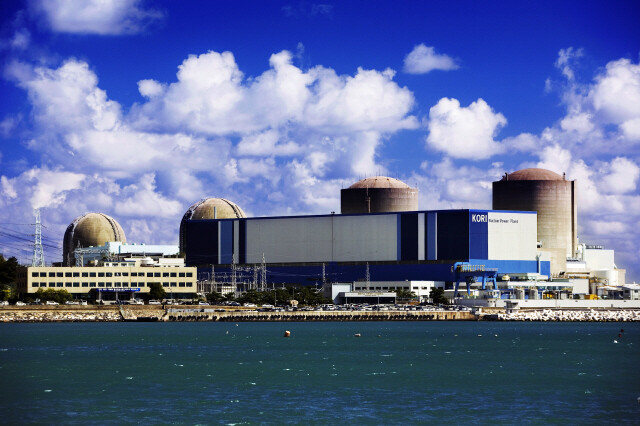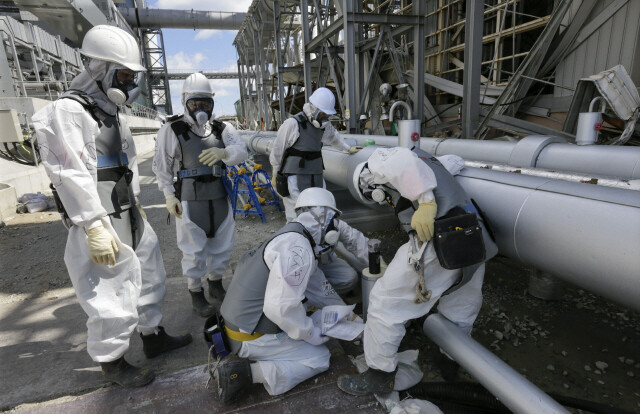hankyoreh
Links to other country sites 다른 나라 사이트 링크
Government votes for the first time to decommission a nuclear power facility

The South Korean government has begun the first decommissioning of a nuclear power generating facility in history with its recommendation to permanently shut down a power plant that first went into commercial operation 37 years ago.
With the closure now set to become a reality, a serious debate is likely to ensue over the fate of the spent nuclear fuel and the permanent disposal of the plant’s waste, along with safety concerns, decommissioning costs, and various hidden social and economic consequences.
During a June 12 meeting at the Lotte Hotel in Seoul’s Sogong neighborhood presided by Minister of Trade, Industry and Energy Yoon Sang-jick, the National Energy Council (NEC) voted to recommend that operator Korea Hydro & Nuclear Power (KHNP) decommission the No. 1 reactor at Kori Nuclear Power Plant.
The plant, located in Busan’s Gijang County, is the country’s oldest commercially operated nuclear power facility.
“We made the decision that a permanent shutdown was in the best of interests of the medium- and long-term development of South Korea’s nuclear power industry, and we plan to issue a recommendation accordingly,” said Yoon after the meeting.
The NEC is an organization for reviewing the country’s energy policies. The June 12 meeting was attended by 19 of its 25 government and civilian members, including the Minister of Trade, Industry and Energy and the Vice Minister of Environment.
The first Kori Reactor started operating in April 1978 and concluded its 30-year design lifespan on June 18, 2007. An extension was later granted for it to run until June 18, 2017.

Because of the safety examination procedures required by law for a second extension application with the Nuclear Safety and Security Commission (NSSC), KHNP would have to submit its request by June 18. The company plans to hold a meeting of its directors on June 16 and 17 to make the final application decision, but the chances of it bucking the administration’s recommendation appear very slim.
If KHNP does decide to decommission the reactor, it will have to submit a dismantling plan to the NSSC by July 2018.
Votes in favor of a permanent shutdown slightly outweighed the nays at the NEC meeting, with Yoon ultimately agreeing on the final decision, the MTIE reported.
KHNP CEO Cho Seok maintained that neither economic feasibility nor safety were concerns for the Kori reactor. But many council members voted in favor of the decommissioning, citing unclear economic prospects and the need to restore the public’s trust in nuclear power after it was damaged by recent confirmed cases of corruption. The ultimate decision reflected pressure from politicians on both sides to shut the reactor down, as well as concerns among local Busan residents.
The administration estimated the decommissioning process would take at least 15 years and cost 600 billion won (US$539 million). But past examples in Japan and other countries suggest both figures could snowball.
The MTIE has said additional costs would “be a factor” in rising electricity rates. It has also assessed South Korea’s nuclear power facility dismantling technology at 70% of levels in advanced economies.
But the lack of experience with dismantling non-research reactors, as well as a shortage of expertise, suggests difficulties may be on the way.
The MTIE has insisted that the question of whether to extend the lifespans of other old reactors in South Korea is a matter to be decided independently.
“It’s not the case that all power plants are denied a second extension,” said energy resource office chief Jeong Yang-ho at a briefing on June 12.
Eleven power plants across the country will be reaching the end of their design lives over the 15 years through 2029.
The nuclear power industry in South Korea has been consistently burgeoning in the 37 years since the first commercially operated nuclear power facility went online with Kori Reactor 1. Citing the cheap production costs and the absence of carbon dioxide or other atmospheric pollutants, the Lee Myung-bak administration (2008-13) drafted a plan for having the percentage of power from nuclear energy increased from just over 20% today to over 40% by 2035.
But the 2011 Fukushima nuclear power plant disaster in Japan ignited a debate over the possible dangers of the energy source. In 2014, the target percentage for 2035 was lowered to 29%. As of late 2014, nuclear power accounted for 23.5% of the country’s electricity.
Despite the council’s decision, the Park Geun-hye administration’s focus is squarely on maintaining or expanding the use of nuclear power.
The first extension decision came on June 11 when the NSSC voted to approve the restarting of the first reactor at Wolseong Nuclear Power Plant, which is scheduled to go back on line sometime this month. In its seventh basic energy supply plan announced on June 8, the MTIE abandoned plans for four new coal-powered plants, but included the building of two new nuclear power facilities. If carried out, it would bring the total in South Korea to thirty-five.
By Song Kyung-hwa and Park Hyun-jeong, staff reporters
Please direct questions or comments to [english@hani.co.kr]

Editorial・opinion
![[Column] Park Geun-hye déjà vu in Yoon Suk-yeol [Column] Park Geun-hye déjà vu in Yoon Suk-yeol](https://flexible.img.hani.co.kr/flexible/normal/500/300/imgdb/original/2024/0424/651713945113788.jpg) [Column] Park Geun-hye déjà vu in Yoon Suk-yeol
[Column] Park Geun-hye déjà vu in Yoon Suk-yeol![[Editorial] New weight of N. Korea’s nuclear threats makes dialogue all the more urgent [Editorial] New weight of N. Korea’s nuclear threats makes dialogue all the more urgent](https://flexible.img.hani.co.kr/flexible/normal/500/300/imgdb/original/2024/0424/7317139454662664.jpg) [Editorial] New weight of N. Korea’s nuclear threats makes dialogue all the more urgent
[Editorial] New weight of N. Korea’s nuclear threats makes dialogue all the more urgent- [Guest essay] The real reason Korea’s new right wants to dub Rhee a founding father
- [Column] ‘Choson’: Is it time we start referring to N. Korea in its own terms?
- [Editorial] Japan’s rewriting of history with Korea has gone too far
- [Column] The president’s questionable capacity for dialogue
- [Column] Are chaebol firms just pizza pies for families to divvy up as they please?
- [Column] Has Korea, too, crossed the Rubicon on China?
- [Correspondent’s column] In Japan’s alliance with US, echoes of its past alliances with UK
- [Editorial] Does Yoon think the Korean public is wrong?
Most viewed articles
- 1‘We must say no’: Seoul defense chief on Korean, USFK involvement in hypothetical Taiwan crisis
- 2N. Korean delegation’s trip to Iran shows how Pyongyang is leveraging ties with Moscow
- 3Amnesty notes ‘erosion’ of freedom of expression in Korea in annual human rights report
- 4[Column] Park Geun-hye déjà vu in Yoon Suk-yeol
- 5‘Weddingflation’ breaks the bank for Korean couples-to-be
- 6[Reportage] On US campuses, student risk arrest as they call for divestment from Israel
- 7[Editorial] New weight of N. Korea’s nuclear threats makes dialogue all the more urgent
- 8Why Korea shouldn’t welcome Japan’s newly beefed up defense cooperation with US
- 9[Guest essay] The real reason Korea’s new right wants to dub Rhee a founding father
- 10Will NewJeans end up collateral damage in internal feud at K-pop juggernaut Hybe?